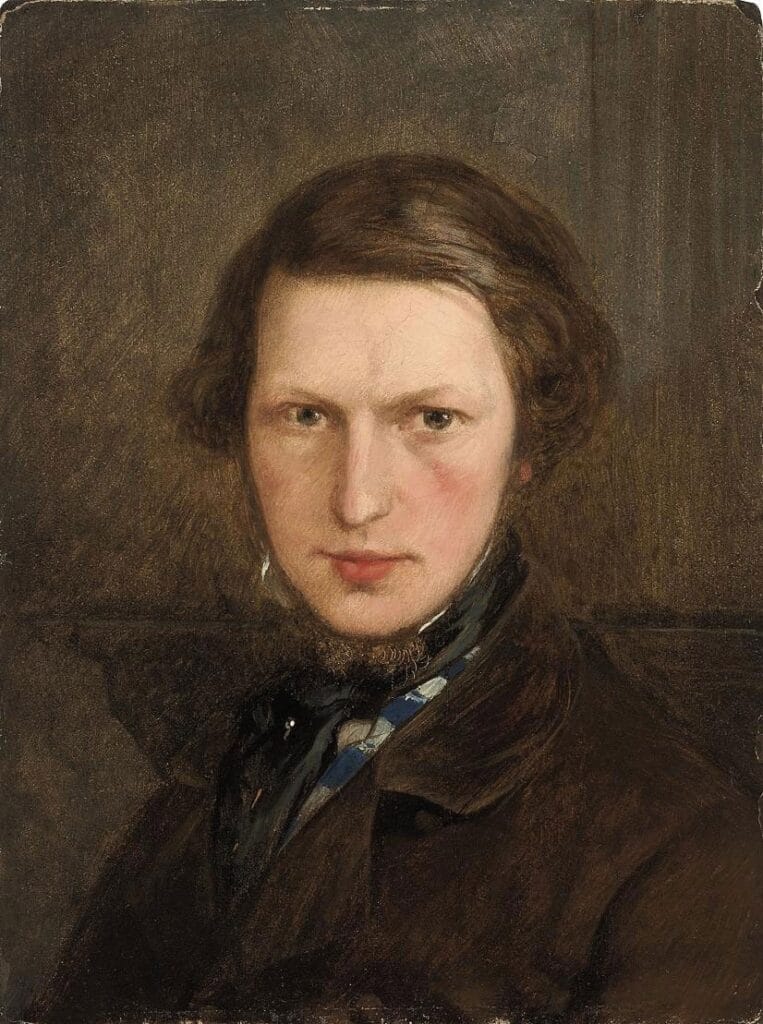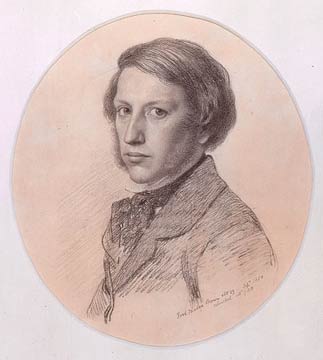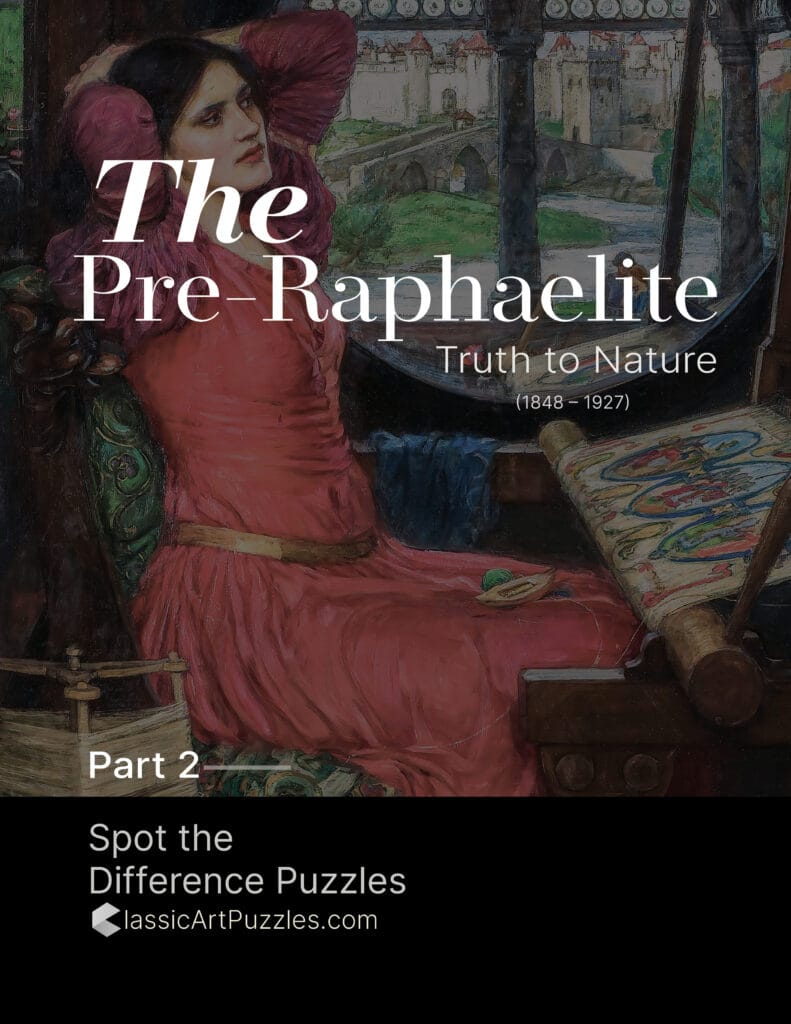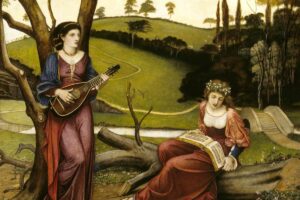Table of Contents
Overview
Painted in 1844 by Ford Madox Brown (1821–1893), The Bromley Family presents a Victorian domestic group with vivid detail and a sense of quiet storytelling. The family sits arranged beneath a canopy of greenery, their expressions ranging from reflective to conversational. At the heart of the work is not only likeness but atmosphere: a portrayal of middle-class identity, affection, and individual personality within a shared whole.
This painting predates the foundation of the Pre-Raphaelite Brotherhood but already demonstrates qualities that would define the movement — precision in detail, a richness of color, and a commitment to truth over idealization. Brown’s family portrait is as much about realism as it is about narrative, placing ordinary people into a setting imbued with symbolic echoes of growth, legacy, and domestic harmony.
Today, The Bromley Family is seen as a crucial stepping stone in Brown’s career, a bridge between Victorian portraiture and the symbolic, socially engaged art he would later create.
Artist
Ford Madox Brown (1821–1893) was a British painter closely associated with, though never officially a member of, the Pre-Raphaelite Brotherhood. Known for his socially conscious themes, vibrant colors, and innovative compositions, Brown influenced artists such as William Morris and Dante Gabriel Rossetti. His work often combined moral seriousness with richly detailed realism, and his masterpiece Work is among the most important social-realist paintings of the 19th century.

The Story Behind the Painting
Commission and Purpose
The Bromley Family was commissioned as a portrait, designed to capture both likeness and familial character. Unlike many portraits of the time, it avoids stiff formality and instead creates a sense of lively interaction.
A Domestic Ideal
Each figure holds a presence of individuality: women dressed in silks and lace, men in tailored coats, their grouping suggesting conversation, care, and connection. The central female figure’s bridal attire may allude to marriage, transition, and legacy.
Symbolism and Setting
The family is placed beneath a trellis of vines, a symbol of life and continuity. Domestic items — books, flowers, a dog — reinforce themes of loyalty, affection, and cultivated taste.
Composition and Subjects
Arrangement of Figures
The six sitters form a carefully balanced triangle. The gestures — a raised hand, a thoughtful glance, an extended arm — animate the scene, transforming it from static portraiture into narrative tableau.
The Dog
At the base of the painting sits a small dog, its watchful eyes symbolizing fidelity and domestic guardianship.
Background
The open sky behind the vine-covered arch suggests not only domestic enclosure but a broader horizon, tying private life to the wider world.
Art Style and Techniques
Realism with Romantic Hints
Brown’s detail in fabrics, facial features, and objects reflects a commitment to accuracy, but his use of symbolic placement hints at the deeper narrative layers that would characterize later Pre-Raphaelite works.
Color and Light
Rich greens, whites, and blacks dominate, with splashes of rose and gold. The tonal harmony enhances the sense of refinement and unity within the group.
Early Pre-Raphaelite Influence
Although painted before 1848, The Bromley Family foreshadows Brown’s alignment with Pre-Raphaelite ideals: sincerity, moral gravity, and visual precision.
Featured in Our Collection
The Bromley Family is part of our Pre-Raphaelite Spot-the-Difference Puzzle Flipbook P2. With its subtle gestures, floral details, and intricate costumes, it becomes an engaging puzzle that celebrates both realism and narrative storytelling.
A Victorian Conversation
Six sitters beneath a vine, their glances weaving a silent conversation, a dog at their feet, and objects hinting at loyalty and legacy. In Brown’s The Bromley Family, domestic portraiture becomes a meditation on continuity, presence, and affection.
More About Artist

Ford Madox Brown (16 April 1821 – 6 October 1893) was a British painter notable for his moral and historical subjects, recognized for his distinctive graphic and often Hogarthian version of the Pre-Raphaelite style. He was a significant figure in the Victorian art world and played an important role in influencing the Pre-Raphaelite Brotherhood. Brown spent his later years creating the twelve works known as The Manchester Murals for Manchester Town Hall, depicting historic Mancunian events with vivid detail.
Artist Style and Movement
Brown’s early work was grounded in the European academic tradition and influenced by studying Old Masters such as Rembrandt and Spanish painters in the Louvre. He combined vigorous realism with richly detailed narrative scenes imbued with social commentary, moral lessons, and historical accuracy. His work bridges early Pre-Raphaelite ideals with later Victorian concerns, distinguished by bold color use, complex compositions, and emotional expressiveness.
Artwork Profile / Notable Works
- The Bromley Family (1844): An early significant work showing portraits of his cousin’s children, reflecting his formative style with somber tonality and romantic background.
- Work (1852–1865): Brown’s masterpiece mural celebrated for its social realism and depiction of Victorian labor and industry.
- Chaucer at the Court of Edward III (1851): A richly detailed historical scene reflecting Brown’s scholarly and narrative interests.
- Pretty Baa-Lambs (1851): An intimate genre scene showing children with lambs, highlighting Brown’s interest in rural life.
- The Last of England (1852–1855): A poignant and influential painting depicting emigration from England.
- The Manchester Murals (1879–1893): A series of twelve large murals illustrating historical events in Manchester’s history, demonstrating Brown’s mature style combining narrative power with artistic grandeur.
Ford Madox Brown’s career was pivotal to the development of Victorian art, blending detailed academic training with social awareness and Pre-Raphaelite aesthetics. His influence extended through his teaching and associations with other artists, impacting the direction of British art in the 19th century. His compassionate yet critical portrayals of life and history make his work enduringly significant.




